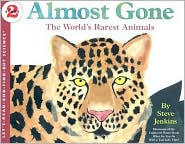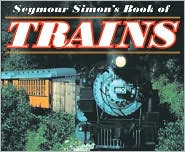 BIBLIOGRAPHY
BIBLIOGRAPHYJenkins, Steve. (2006). ALMOST GONE: THE WORLD’S RAREST ANIMALS. Let’s-Read-and-Find-Out science. NY: Harpercollins Publishers. ISBN: 0060536004.
PLOT SUMMARY
With colorful collages, Steve Jenkins introduces twenty-seven animals from around the world that are endangered, extinct, and that are returning.
CRITICAL ANALYSIS
Almost Gone: The World’s Rarest Animals is part of the popular series Let’s-Read-and Find-Out Science. This series was developed by numerous professionals within the fields of science, and for each book that is created by various authors the text and illustrations are checked for accuracy by an expert (Jenkins, p. 2). With this level of expertise, Jenkins has written and illustrated an extremely fun and educational book.
The book is well organized. For the majority of the book, each animal has its own page; however for larger animals such as the Northern Right Whale have an entire double-page spread. There are three official areas of the books. The first being the Almost Gone (endangered) animals, second is the Gone Forever (extinct) animals, and finally there are the Coming Back animals. Each endangered animal is first introduced by a heading that presents its name, the country its from, and how many are left, for example for the Northern Hairy-Nosed Wombat is from Australia and there are fewer than 60 left (Jenkins, p. 7). For the Gone Forever animals the headings provide their names, the country where it was from, and the year that become extinct. An even simpler heading of name and country is used for the Coming Back animals.
To mark each section, Jenkins provides a little tidbit to the readers to learn more about the different aspects of rare animals. For example, he states that the numbers of the animals remaining is an estimated guess made by scientist who study those specific animals (Jenkins, p. 3), and to explain the animals that are “coming back” were once close to extinction but were able to multiply due to the help of human beings “acting to protect their habitats” (p. 32).
To begin Almost Gone: The World’s Rarest Animals, Jenkins introduces the readers to the interdependence of the animals by using the little Chickadee bird, which is not endangered but still a animal for the example, who is responsible eating insects that would attack a garden full, who spread and fertilize the seeds of the berries it eats, and are the birds that large hawks eat who in turn eat rats and mice (p. 4). Through this circle of life, the author paints a picture of how disruption, such as a rare number of Chickadees, in the circle can endanger a species of animals and bring them to the risk of extinctions.
The text comes in the form of a single paragraph per animal that describes the physical characteristics, the home, and the cause of why the animal is endangered, extinct, or reemerging. The sentences are easily readable and understandable due to use of clear words. Despite the fact that there is only one paragraph that is dedicated to each animal, the text is nonetheless presents a detailed life story of the animal.
The collages that depict all of the animals are amazingly detailed. Jenkins uses an array of colorful and various textured handmade papers to create each animal. The papers’ color and it visual as well as the physical texture is the key to creating the illustrations. Jenkins used a paper that had the look of soft brown and cream-colored velvet to represent the skin of the Abington Island Tortoise. To provide the appearance of fluffy fur seen on the Iriomote Cat, the Assam Rabbit, and the Bactrian Camel, paper with high fiber content was used and instead of being clean-cut, the edges were frayed to enhance the look of fur.
To close this wonderful book, Jenkins provides a world map, which is appropriately made out of paper with deep green and cream swirls, covered in numbers. In a legend categorized the same way as the book, there are the corresponding numbers that provides the names, its location, and its estimated size dimensions.
Through his well-organized, clear story-like text, and beautiful collages, Jenkins’ Almost Gone: The World’s Rarest Animals is a great educational book that will captivate its young readers and to distill an interest in the animals that are reducing in numbers and the animals that are recovering from lack of population.
BOOK REVIEWS
HORN BOOK GUIDE
Jenkins first discusses the interdependence of living things, then portrays twenty-eight endangered and extinct animals. Each profile includes a striking cut-paper rendering of an animal along with a paragraph about the animal's habits and habitat and why its population has dwindled. While the book is informative, it lacks the narrative structure and rich conceptual focus typical of previous entries in the series. Copyright 2003 of The Horn Book, Inc. All rights reserved. (October 1, 2006)
SCHOOL LIBRYR JOURNAL
K-Gr 3-This engaging title is informative as well as visually stunning. Jenkins captures the essence of his subjects with appropriately colored, cut-paper collage illustrations on stark white backgrounds. Each endangered animal is introduced in a single paragraph that typically contains a fact or two about its range, behavior, diet, and those conditions that threaten its welfare. The actual number remaining is poignantly noted. A middle section, "Gone Forever," memorializes animals no longer on Earth with an indication of when they were last seen. In a hopeful third section, Jenkins discusses the Indian crocodile, whooping crane, and Alpine ibex, three animals that are "coming back," due to the efforts to protect their habitats. All the animals included in this book are numbered and appropriately placed on a double-page world map. Those who have enjoyed Patricia Mullins' V for Vanishing (HarperCollins, 1997) or Alexandra Wright's Will We Miss Them? (Charlesbridge 1991) will definitely gravitate toward this offering. Report writers may need more extensive information but the beauty of this book justifies its inclusion on most library shelves.-Gloria Koster, West School, New Canaan, CT Copyright 2006 Reed Business Information. (February 1, 2006)
CONNECTIONS
*Learn more about endangered and extinct animals with book like The Best Book of Endangered and Extinct Animals by Christiane Gunzi
*Read books about wildlife conservation like Pamela Hickman’s Turtle Rescue: Changing the Future for Endangered Wildlife.
*Explore websites about endangered animals like The American Museum of Natural History’s Endangered!: Exploring a World at Risk and the website Kids go Wild!: Wildlife Conservation Society.
*Discuss with the children how they can help protect the endangered animals.


